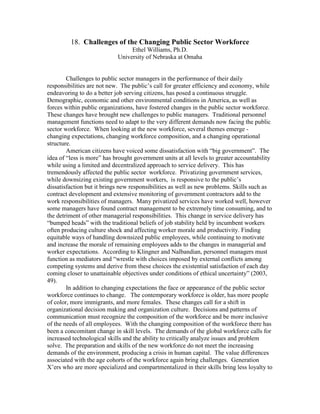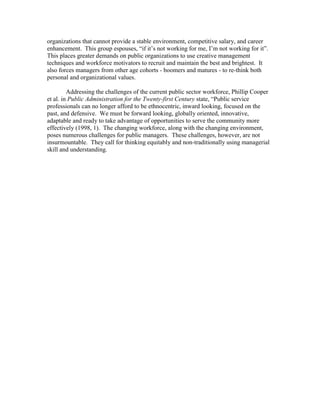Challenges
- 1. 18. Challenges of the Changing Public Sector Workforce Ethel Williams, Ph.D. University of Nebraska at Omaha Challenges to public sector managers in the performance of their daily responsibilities are not new. The publicâs call for greater efficiency and economy, while endeavoring to do a better job serving citizens, has posed a continuous struggle. Demographic, economic and other environmental conditions in America, as well as forces within public organizations, have fostered changes in the public sector workforce. These changes have brought new challenges to public managers. Traditional personnel management functions need to adapt to the very different demands now facing the public sector workforce. When looking at the new workforce, several themes emerge - changing expectations, changing workforce composition, and a changing operational structure. American citizens have voiced some dissatisfaction with âbig governmentâ. The idea of âless is moreâ has brought government units at all levels to greater accountability while using a limited and decentralized approach to service delivery. This has tremendously affected the public sector workforce. Privatizing government services, while downsizing existing government workers, is responsive to the publicâs dissatisfaction but it brings new responsibilities as well as new problems. Skills such as contract development and extensive monitoring of government contractors add to the work responsibilities of managers. Many privatized services have worked well, however some managers have found contract management to be extremely time consuming, and to the detriment of other managerial responsibilities. This change in service delivery has âbumped headsâ with the traditional beliefs of job stability held by incumbent workers often producing culture shock and affecting worker morale and productivity. Finding equitable ways of handling downsized public employees, while continuing to motivate and increase the morale of remaining employees adds to the changes in managerial and worker expectations. According to Klingner and Nalbandian, personnel managers must function as mediators and âwrestle with choices imposed by external conflicts among competing systems and derive from these choices the existential satisfaction of each day coming closer to unattainable objectives under conditions of ethical uncertaintyâ (2003, 49). In addition to changing expectations the face or appearance of the public sector workforce continues to change. The contemporary workforce is older, has more people of color, more immigrants, and more females. These changes call for a shift in organizational decision making and organization culture. Decisions and patterns of communication must recognize the composition of the workforce and be more inclusive of the needs of all employees. With the changing composition of the workforce there has been a concomitant change in skill levels. The demands of the global workforce calls for increased technological skills and the ability to critically analyze issues and problem solve. The preparation and skills of the new workforce do not meet the increasing demands of the environment, producing a crisis in human capital. The value differences associated with the age cohorts of the workforce again bring challenges. Generation Xâers who are more specialized and compartmentalized in their skills bring less loyalty to
- 2. organizations that cannot provide a stable environment, competitive salary, and career enhancement. This group espouses, âif itâs not working for me, Iâm not working for itâ. This places greater demands on public organizations to use creative management techniques and workforce motivators to recruit and maintain the best and brightest. It also forces managers from other age cohorts - boomers and matures - to re-think both personal and organizational values. Addressing the challenges of the current public sector workforce, Phillip Cooper et al. in Public Administration for the Twenty-first Century state, âPublic service professionals can no longer afford to be ethnocentric, inward looking, focused on the past, and defensive. We must be forward looking, globally oriented, innovative, adaptable and ready to take advantage of opportunities to serve the community more effectively (1998, 1). The changing workforce, along with the changing environment, poses numerous challenges for public managers. These challenges, however, are not insurmountable. They call for thinking equitably and non-traditionally using managerial skill and understanding.


